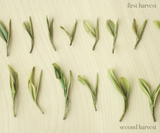Wild Purple Shoots First Harvest
明前顾渚紫笋
Harvest
March 25, 2022
Origin
Guzhu Mountain, Changxing, Huzhou
First Harvest Green Tea, called 明前绿茶 in Chinese, is the most prestigious and precious harvest of green tea each year. Tea connoisseurs eagerly anticipate the arrival of these teas that lift us out of Winter. The Chinese name for First Harvest, 明前绿茶, translates to “Pre-Qingming,” meaning they were harvested before Qingming. Qingming, or “Pure Brightness,” is a solar term in the traditional Chinese lunar calendar. There are 6 solar terms for the Spring season, starting in early February: “The Beginning of Spring”, “Rain Water”, “The Waking of Insects”, “Spring Equinox”, “Pure Brightness”, and “Grain Rain.”
This year, Pure Brightness falls on April 5th and Grain Rain starts on April 20th. Green teas harvested before Pure Brightness, “Pre-Qingming,” are considered the most precious because the weather is still notably cooler, meaning the tea leaves grow more slowly, and the number of buds are less. The trees have been dormant all Winter; these are the first sprouts of the year. These leaves will have the most nutrients in them, which intensifies the complexity and depth of their taste.
After Pure Brightness the weather grows warmer, it rains more in the mountains, and as such the tea leaves grow more quickly.
First Harvest teas offer a very special encounter with tea in its youth: with its intense greenness, and uplifting qualities.
Purple is not a common colour for green tea leaves, nor is it a common colour for anything else in the natural world. However, every Spring, the trees of Wild Purple Shoots 顾渚紫笋茶 produce light purple buds. The way that these purple buds stand out against both one’s expectations and the varied greens of the jungle around them has historically evoked some wonder.
Wild Purple Shoots grows in the remote jungles of the Guzhu Mountain Range in Changxing, Huzhou. This area is so difficult to get to that it is said that this ancient varietal of wild tea “comes down from the clouds”. Wild Purple Shoots was a favourite of Lu Yu, the highly-respected poet and self-taught scholar who authored what remains one of the most important texts on tea ever written, The Classic of Tea, around 780 AD. In this text, in regards to tea from Guzhu Mountain, (where he eventually settled to live and craft tea himself), Lu Yu wrote, very simply, that “purple is better than green.” During the Tang Dynasty, Wild Purple Shoots was a tribute to the emperor, however it took so long to carry this tea to him from high up in the tree-covered mountains where it grew that this practice eventually fell out of favour, and the tea was left in the appreciative hands of locals. On account of this, it remains a highly regarded, however somewhat forgotten, green tea.
Being forgotten has created a very special opportunity for this tea; it has allowed it to remain entirely unchanged by cultivation. It is astonishing to recognize that the Wild Purple Shoots we drink today will appear exactly as it would have during the Tang Dynasty. With the exception of Spring harvests, these trees continue to grow unwitnessed, as they always have, scattered between the rocks and towering bamboo of the higher altitudes in the Guzhu mountains, obscured by a mist that never clears. Each Spring their leaves are delicately harvested by hand while they are still their mesmerizing purple colour. They turn green while being roasted over charcoal, dispelling their coolness along with their unusual colour.
While untended by humans, the temperate microclimate of the dense valley these trees preside over maintains the ideal conditions for producing green tea. Tai Lake, one of the largest freshwater lakes in China, is nearby, lending extra moisture and coolness to the air, thus slowing the growth of the tea leaves. The soil on the mountains is made up mostly of granite and purple sandstone: mineral-rich and nutrient-scarce, which means the tea trees must extend their roots deeper into the earth for nourishment, making them more concentrated and robust.
Wild Purple Shoots is a clarifying, single-minded tea. It opens slowly to a taste that holds floral and vegetal notes in balance. It can taste like orchid, grass, and fruit - at once. (Like wisdom, it could be easily dismissed for appearing simple, and being slow to unfold). In the gaiwan the varied leaves of Wild Purple Shoots twist and bend in every direction, and they produce a liquor that seems to move in as many and all directions throughout the body. The tea feels hydrating, and lays deep in the mouth. If you follow it into the fourth or fifth infusions you will see more of this tea: either because the tea is showing more of itself, or it has made you better able to be present with it – which is the case, we’ll never know.
This year's First Harvest Wild Purple Shoots is beautiful and sublime. The one-bud-one-leaf are tender and plump. Drinking this tea brings us back to the peak of the magnificent mountains with gigantic bamboo trees. It is delicate, gentle, full-bodied with a deep mouthfeel. It is a purist's tea. Sweet, single-minded, with hints of vegetal, grassy and orchid notes.
. . .
Brewing guide
| Tea | 3g |
| Temperature |
80°C |
| Water | 120 ml |
| Steep time | 10 - 60 sec |
| No. of infusions | 6 |




















